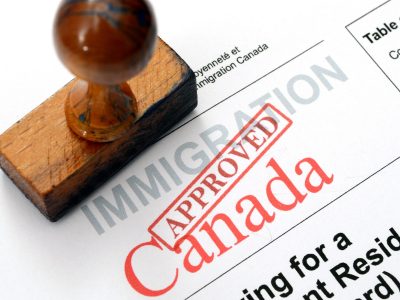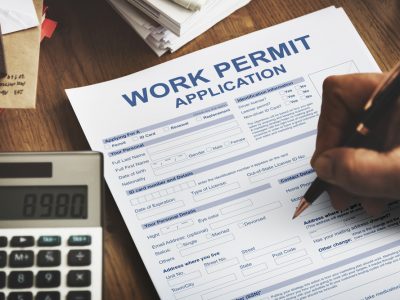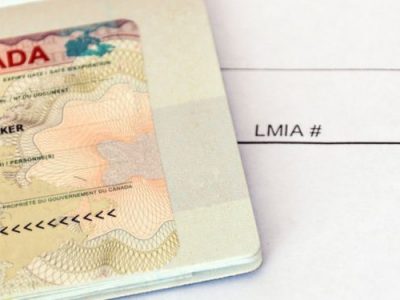Before you start working in Canada, you need to take these 10 steps:
- Find out about your NOC
- Pass a language test
- Prepare a CV
- Get an Educational Credential Assessment
- Find a job
- Wait for your employer to get an LMIA
- Get a job offer
- Undergo a medical exam
- Get a work permit
- Get a visa
 1. Know Your NOC
1. Know Your NOC
Before you apply for a job in Canada, you need to know your level in National Occupational Classification (NOC) which is a four-digit code. You can find your NOC on the Government of Canada website by entering your occupation. For instance, if you are a web developer, your NOC is 2175, and your skill level is A.
There are 5 NOC levels for immigration purposes:
- 0: management jobs (senior managers, legislators) — your NOC should start with 0 (for example, 0016)
- A: professional jobs that usually require a university degree (architects, doctors, dentists) — your NOC’s second digit should be 0 or 1 (for example, 3113)
- B: technical jobs and skilled trades that usually require a college diploma or training as an apprentice (plumbers, welders, electricians) — your NOC’s second digit should be 2 or 3 (for example, 7251)
- C: intermediate jobs that usually require high school or specific training (truck drivers, industrial butchers, food and beverage servers) — your NOC’s second digit should be 4 or 5 (for example, 7511)
- D: labour jobs that usually give on-the-job training (cleaning staff, fruit pickers, oil field workers) — your NOC’s second digit should be 6 or 7 (for example, 6741)
NOC is used by Canadian immigration programs to determine if work experience meets their eligibility criteria. If you want to come to Canada as a skilled worker through Express Entry programs (the Federal Skilled Worker Program, Federal Skilled Trades Program, Canadian Experience Class), you need to have NOC Skill Type 0, A or B. If your job is skill level C or D, you may be able to immigrate as a provincial nominee or through the Atlantic Immigration Pilot.
 2. Pass a Language Test
2. Pass a Language Test
Canada has two official languages, English and French. It is impossible to find a job in Canada (even a low-qualification one) without being skilled in one of these languages.
You need to have proof of your English or French skills before applying for an immigration program. To do so, you need to take the IELTS or CELPIP test (if you speak English) or the TEF or TCF test (if you speak French). You can do it in your home country or in Canada. For instance, taking the IELTS test in Canada costs C$309–319 and it includes four modules: Listening, Reading, Writing, and Speaking. You can gain different points for each module, but your average point should not be lower than 4.0, 5.0 or 6.0 depending on the immigration program.
Express Entry programs use the Canadian Language Benchmark (CLB) to assess your language level. You can find tables of CLB levels for each kind of tests on the Government of Canada website.
 3. Prepare a Canadian-style CV
3. Prepare a Canadian-style CV
A well-written CV can land you your dream job, and it is really important as the employer will get the first impression of you based on your resume.
The CV format in Canada may be quite different from resumes you may be used to writing in your home country. To appeal to a Canadian employer, you need to prepare a Canadian-style CV in English or French (or both).
First of all, your CV must include:
- Contact information (name, address, professionally looking email, phone number, your LinkedIn profile URL)
- Career summary (write the title of your target position and add 3–4 short sentences to outline personal traits, professional skills or talents that make you different — but try to avoid generic comments)
- Work experience (list only relevant information)
- Education and professional development (you may also include volunteer experience and community involvement)
A Canadian-style resume should meet the following criteria:
- Your CV should fit in 1 page, be readable and printer-friendly. Use short sentences, avoid long paragraphs and small fonts. Your employer should waste no more than 30 seconds to read your resume
- It is better to prepare a “customized” CV for every job vacancy you are interested in using specific keywords related to the job
- Include information about the most relevant work experience and education. Include only skills relevant to the position for which you are applying
- Translate your resume into French in addition to English — sometimes it is required by employers
- Do not add your photo: the employer should evaluate your professional skills and not base his impression on your appearance
- Do not list your date of birth, gender, marital status, hobbies, and preferences
- Do not use the first person (“I”, “me”, “my”). Use simple sentences and verbs of action (“handled”, “managed”, “developed”, “increased”, “accomplished”)
- Do not use more than 7 bullet points in your CV
- Do not attach letters of reference (unless your employer asks to do so)
And, obviously, there should be no place for poor spelling and bad syntax in your CV. Also, you can use a specialized website to optimize your CV.
Keep in mind that you may have to send your CV hundreds or even thousands of times before you find a job in Canada.
 4. Get an Educational Credential Assessment if Needed
4. Get an Educational Credential Assessment if Needed
If you wish to immigrate to Canada, it is advisable — though not always mandatory — to get your academic credentials evaluated as it will allow you to get up to 150 of additional points in the Express Entry system. The evaluation is required to apply for certain immigration programs.
In most cases, bachelor’s and master’s degrees in foreign learning institutions equal bachelor’s and master’s degrees in Canadian universities. However, only completed degrees or diplomas can be evaluated.
The process of evaluation of academic credentials is called the Educational Credential Assessment (ECA). The government of Canada only accepts assessments issued by the designated organizations:
- Comparative Education Service: University of Toronto School of Continuing Studies
- International Credential Assessment Service of Canada
- World Education Services
- International Qualifications Assessment Service
- International Credential Evaluation Service
- Medical Council of Canada (if your primary occupation is specialist physician, general practitioner or family physician)
- Pharmacy Examining Board of Canada (if you care for patients in a hospital pharmacy, long term care facility or community pharmacy)
Most immigrants apply for an ECA in World Education Services (WES). To do so, you need to provide the following documents:
- A diploma or a degree certificate. For some countries, it may be required to verify the original document by apostille
- A list of subjects and grades for each year of study
- Precise translations (if your academic documents are not issued in English) made by your institution, a certified translation agency or any other professional translation service. Do not send your original translations as they will not be returned
In WES, an ECA for employment costs C$115, and an ECA for immigration is priced at C$220.The additional expenses include shipping costs (from C$7), and tax of around C$26. In total, the minimum costs of an ECA for immigration purposes stand at minimum C$253.
The standard processing time in WES is 35 business days (much faster than in other organizations: e. g., in ICAS, it takes 6 months). Your ECA report will be also delivered electronically to Immigration, Refugees and Citizenship Canada (IRCC). An ECA report is valid for 5 years.
 5. Find a Job
5. Find a Job
It is recommended to come to Canada to look for a job as it may be difficult to do so from overseas. If you arrive in Canada with a tourist visa, you are not allowed to work, but you can go to job interviews.
Most people find jobs in Canada online. Popular websites include:
- www.monster.ca
- www.indeed.ca
- www.eluta.ca
- www.glassdoor.ca/index.htm
- www.linkedin.com
- www.jobbank.gc.ca/home
- www.wowjobs.ca
- www.kijiji.ca
- www.workopolis.com/en
- https://www.ziprecruiter.com
- https://www.nbjobs.ca
- https://workpei.ca
Be aware that jobs posted as street advertising usually are a fraud. Also, keep in mind that accepting offers from employment agencies may be risky sometimes too.
 6. Wait for Your Employer to Get an LMIA
6. Wait for Your Employer to Get an LMIA
A Labour Market Impact Assessment (LMIA) is a document from Employment and Social Development Canada that an employer in Canada may need to get before hiring a foreign worker. A positive LMIA (a confirmation letter) will show that no Canadian worker is available to do the job and that there is a need for a foreign worker to fill the job.
There is the facilitated LMIA process for Quebec employers.
You might be exempt from an LMIA in these cases:
- Mobilité Francophone allows Canadian employers to hire French-speaking and bilingual workers from abroad, to work outside of Quebec in professional, managerial, technical and skilled trades occupations
- If you are between 18 and 35 years old, you can have a temporary work permit under the International Experience Canada program
Click here to read more about the Labour Market Impact Assessment (LMIA).
 7. Get a Job Offer
7. Get a Job Offer
You need a job offer to get a visa and a temporary work permit. Having a job offer is mandatory to be eligible for most provincial immigration programs in Canada and it allows to get extra points in the Express Entry system if you apply under one of the federal programs.
Click here to read more about a job offer for immigration purposes
 8. Undergo a medical exam
8. Undergo a medical exam
You may need a medical exam to get a work permit if:
- You wish to work in a job where it is important to protect public health (health services, childcare, primary or secondary education)
- You will be working in an agricultural job and you have lived in a designated country
- You want to work in Canada for more than 6 months, and you lived in a designated country for 6 consecutive months during the year before the date you intend to come to Canada
Find out whether your country is a designated country here.
Only Panel Physicians approved by Immigration, Refugees and Citizenship Canada can do the medical exam for the purpose of immigration. You can find a Panel Physician in your country here.
 9. Get a Work Permit
9. Get a Work Permit
In general, you need to apply for a work permit from Immigration, Refugees and Citizenship Canada (IRCC) or a Canadian visa office before you come to Canada. For these work permits, you need to get a job offer from a Canadian employer who should apply for an LMIA from Employment and Social Development Canada (ESDC). Then, ESDC will decide whether the employer can hire a foreign worker to fill the job.
You can apply for a work permit on the Government of Canada website. To do so, you will need:
- A Job Offer Letter
- Proof that your employer has submitted a job offer of employment through the Employer Portal
- A contract
- A copy of an LMIA and an LMIA number
- The Port of Entry (POE) Letter of Introduction that you will receive from IRCC if you have been approved for a work permit
- Passports for you and your family members who move to Canada with you
- Birth certificates and a marriage certificate, if applicable
- Evidence that you meet the requirements of the job offer (employment references, education certificates, proof of professional qualifications)
- Results of language tests
- Proof of personal funds
- Biometrics
The fees for getting an employer-specific work permit are C$155 and C$100 for an open work permit.
Some jobs do not require a work permit (you can find the list here).
 10. Get a Visa, if Applicable
10. Get a Visa, if Applicable
Depending on your citizenship, you may need an Electronic Travel Authorization (eTA) or a visitor visa. It will be issued at the same time as your work permit so you do not have to apply separately or pay an additional fee.
